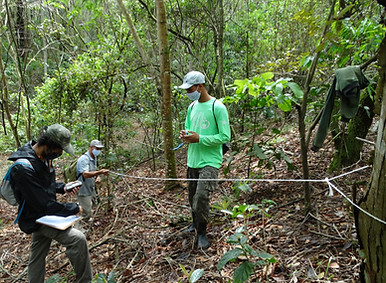
MONITORAMENTO FLORESTAL
Para se alcançar bons resultados em projetos de restauração florestal também é essencial que seja realizada, periodicamente, a manutenção das áreas, a fim de oferecer total condições para o bom desenvolvimento das mudas no campo. Para isso, esta ação é realizada pelo período mínimo de 24 meses após o plantio, até que seja observado o total recobrimento e sombreamento do solo pelas mudas e assim, promover a saída das plantas daninhas do sistema, a fim de combater a competição das mesmas por água, luz e nutrientes. Nesta etapa, são realizadas as atividades de coroamento das mudas, capinas de limpeza do terreno, controle de formigas cortadeiras, adubação de cobertura e/ou foliar e reposição (replantio) de falhas.

Colaboradores em monitoramento ambiental da REGUA - © REGUA
Para acompanhar se a nova floresta está se desenvolvendo adequadamente e cumprindo o seu papel ecológico é necessário monitorar e avaliar o seu crescimento. O objetivo do monitoramento florestal é acompanhar a evolução e medir tanto a qualidade como o sucesso dos plantios, observando o restabelecimento dos processos e funções ecológicas. Para isso temos duas etapas periódicas de monitoramento: a primeira, que atende a Resolução INEA nº 143 de 14 de junho de 2017 e tem como objetivo avaliar a qualidade dos plantios; e a segunda, que avalia a biomassa acumulada e o estoque de carbono nos plantios de restauração, a longo prazo.
Para nós, é muito gratificante observar as primeiras florações e frutificações das mudas plantadas em cada área restaurada. Também é muito interessante observar nesses locais a chegada espontânea de novas plantas, colonizando a regeneração natural, e de animais, como insetos, aves, roedores e pequenos mamíferos. Estes indicadores-chave estão diretamente relacionados ao funcionamento do ecossistema e a efetividade e sucesso da restauração, garantindo assim a sustentabilidade dessas áreas.

Equipe de monitoramento florestal coletando dados - © REGUA

Assim, podemos dizer que o sucesso nos projetos de restauração ambiental da REGUA é resultado de duas décadas de muito trabalho, que implica no envolvimento de parceiros, nos esforços entre as partes envolvidas, na experiência da instituição e no bom funcionamento de toda a cadeia produtiva da restauração florestal.
